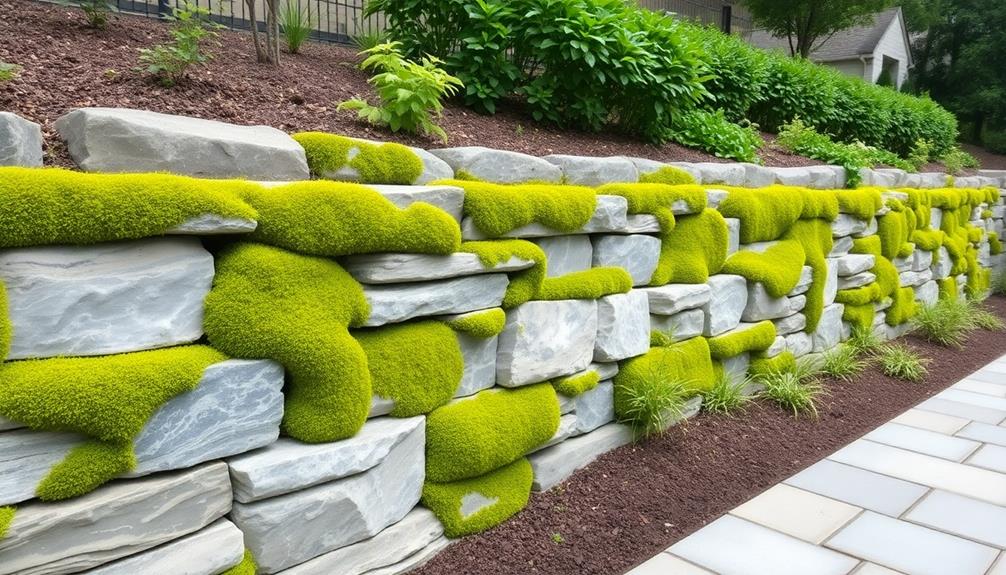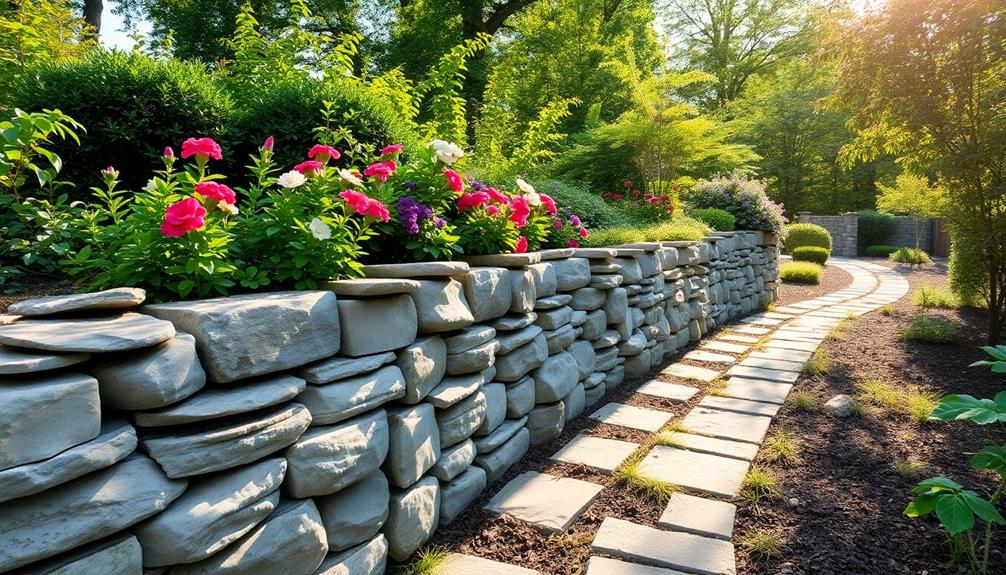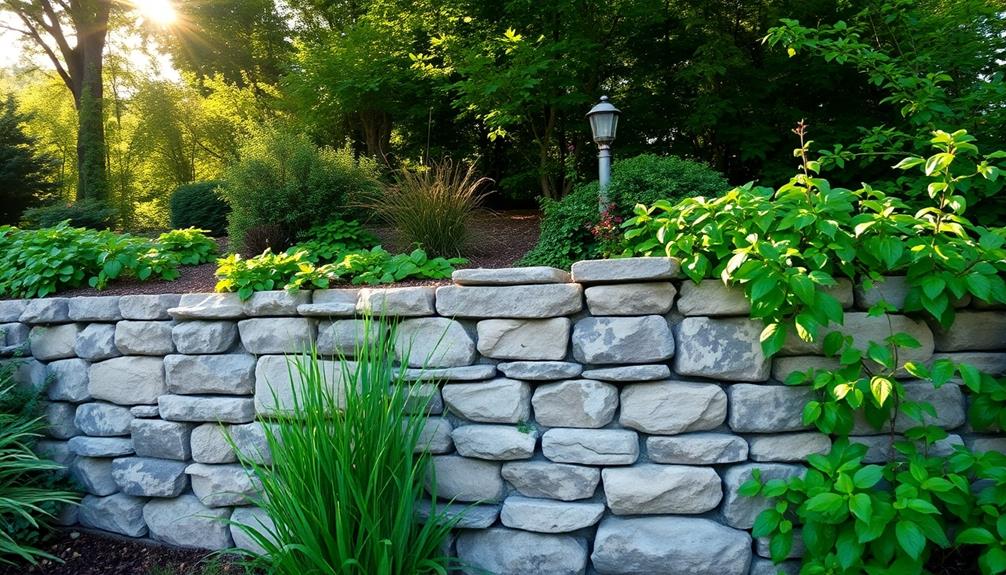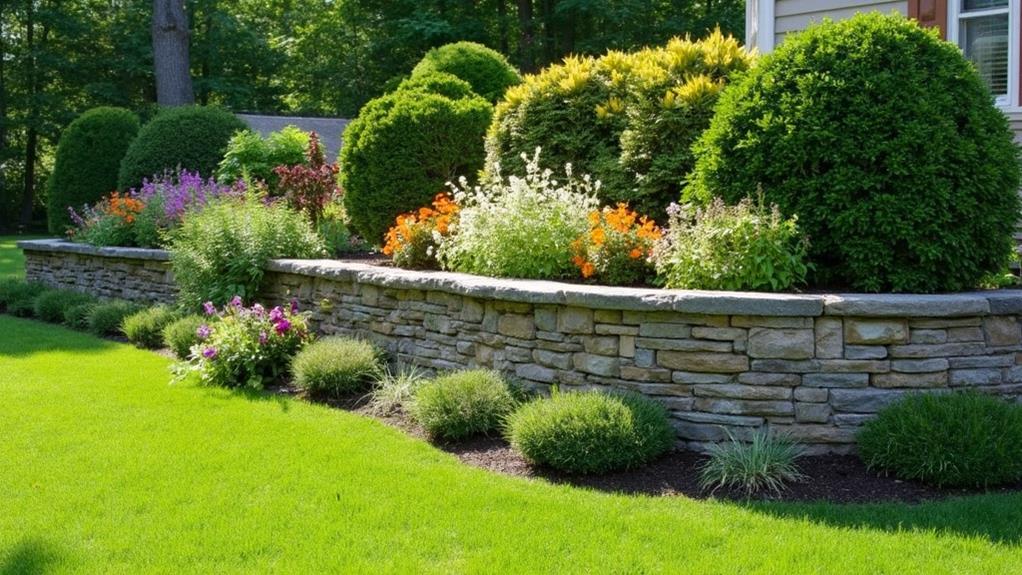Retaining wall maintenance is essential for ensuring their durability and visual appeal, involving strategic inspections, effective drainage solutions, and stringent vegetation control. Regular inspections, particularly after severe weather, help identify structural issues like sagging or joint weakening. Maintaining clear drainage systems, including weep holes and slopes, mitigates hydrostatic pressure risks, protecting the integrity of the wall. Selecting non-invasive vegetation and routinely trimming can prevent excess strain on the structure, while an understanding of local climate influences and material selection enhances resilience. For those seeking to optimize their retaining wall's longevity and function, a methodical approach is indispensable.
Table of Contents
ToggleWalls Contractor Highlights
- Conduct annual and post-weather inspections to detect signs of sagging or bulging in retaining walls.
- Maintain effective drainage by routinely inspecting pipes, clearing debris, and ensuring proper water flow.
- Control vegetation with non-invasive plants, regularly prune roots, and trim to reduce weight on the wall.
- Integrate drainage elements like weep holes and gravel-perforated pipes to manage hydrostatic pressure.
- Preserve aesthetics with regular cleaning and eco-friendly materials for enhanced design appeal.
Understanding Retaining Wall Maintenance

Effective maintenance of retaining walls is vital for their longevity and functional integrity, beginning with adhering to regular inspection frequency guidelines that help identify potential issues before they escalate.
It's important to focus on structural integrity and guarantee that all walls meet building code requirements to withstand various weather conditions. Proper upkeep of the drainage system is essential to managing water flow and preventing pressure build-up against the wall, which can lead to structural damage. Additionally, implementing sound vegetation management practices not only enhances the aesthetic appeal but also safeguards the wall by minimizing root damage and soil displacement.
Inspection Frequency Guidelines
Consistency in inspection routines is critical for the longevity and safety of retaining walls. Establishing a systematic inspection schedule not only promotes structural integrity but also provides a sense of assurance and unity among community members reliant on these structures.
Generally, retaining walls should be professionally inspected annually, though more frequent checks may be warranted based on environmental conditions and wall materials. The annual inspection regime should incorporate an all-encompassing evaluation of wall alignment, noting any signs of sagging or bulging which might indicate underlying issues. Additionally, examining the joints for potential weakening or differential movement is essential to gain insights into possible future problems.
Weather conditions, such as heavy rainfall or freezing temperatures, further dictate the need for additional inspections. Post-extreme weather event assessments are advisable to guarantee structural soundness and public safety.
Collaboratively engaging in inspection activities can nurture awareness among those invested in community infrastructure, fostering a collective vigilance. Moreover, retaining well-documented inspection reports enables easy tracking of changes over time, aiding in the proactive maintenance of these indispensable barriers. By adhering to these structured guidelines, communities ensure that retaining walls continue to serve their protective purpose reliably and safely, exemplifying a shared commitment to infrastructure resilience.
Drainage System Maintenance
Managing the drainage system is pivotal for guaranteeing the effectiveness and durability of retaining walls. Adequate drainage reduces hydrostatic pressure, thus preventing water buildup that could compromise the integrity of the wall structure. A well-maintained drainage system involves several critical components, each requiring regular attention to ensure long-term functionality.
Firstly, routine inspections are essential to detect potential blockages or signs of deterioration within the drainage pipes and outlets. This process aids in addressing issues promptly before they escalate. Secondly, maintaining the proper slope and grade is crucial, as these elements facilitate the ideal flow of water away from the wall. Detailed attention to the slope configuration ensures water does not pool at the base, which could undermine the wall's stability.
Additionally, guaranteeing that weep holes and channels remain unobstructed is paramount. Regular cleaning and clearing of debris from these elements allow seamless water discharge. Establishing a preventive maintenance schedule aligns users with the best practices, fostering a sense of community and shared responsibility among property owners. By diligently managing the drainage system, one not only enhances the structural soundness of retaining walls but also contributes to a safer and more cohesive environment for all.
Vegetation Management Practices
Beyond maintaining an effective drainage system, proper vegetation management is integral to the longevity and stability of retaining walls. When considering vegetation, it is essential to select appropriate plant species that will not interfere with the wall's structural integrity. Choose plants with non-invasive root systems to prevent the roots from undermining the wall and compromising its stability. Ground cover plants, such as creeping thyme or sedum, are excellent options as they aid in soil retention without exerting harmful pressure on the wall itself.
Regular inspection and maintenance of the plants around retaining walls contribute additionally to their durability. As vegetation develops, it is prudent to monitor root growth closely, pruning or removing any intrusive plants before they pose a threat. Moreover, routine trimming of overgrown shrubs and trees helps reduce excess weight on the structure, ensuring it remains balanced and secure.
Benefits

Maintaining your retaining wall not only enhances its structural integrity but also contributes to an improved aesthetic appeal that can elevate the overall ambiance of your outdoor space.
With the right materials, such as boulder walls, you can customize dimensions to fit specific needs, ensuring long-lasting durability and versatile designs.
This proactive approach to upkeep can lead to an increase in property value, as well-preserved walls are attractive and signal well-managed property care to prospective buyers.
Additionally, routine maintenance helps in reducing repair costs over time, as addressing minor issues early can prevent them from developing into more costly problems.
Enhanced Structural Integrity
One of the primary benefits of retaining walls with enhanced structural integrity is their ability to withstand significant pressure from soil and water, reducing the risk of collapse. This robustness guarantees that a retaining wall effectively serves its purpose of stabilizing landscapes, consequently providing peace of mind to property owners. The structural soundness of these walls arises from meticulous engineering and high-quality materials that work in synergy to prevent erosion and shifting soil, which not only safeguards nearby structures but also preserves the natural contours of the land.
Enhanced structural integrity also contributes to the longevity of retaining walls, a critical component for those invested in long-term property stewardship. By maintaining their form over years of exposure to environmental stresses, these walls minimize the need for frequent repairs, ultimately proving to be a cost-effective solution. They enable communities to uphold their shared spaces and landscapes with minimal disruption, fostering a sense of security and cohesion among residents who appreciate a well-maintained environment.
Moreover, retaining walls with superior structural integrity can support added functionalities, such as tiered gardening or seating, allowing them to serve dual roles that enhance the usability of outdoor areas.
Improved Aesthetic Appeal
A well-designed retaining wall not only stabilizes the landscape but also enhances its visual appeal, transforming ordinary outdoor spaces into striking architectural elements. The aesthetic value of a retaining wall is a significant factor in the overall landscape design process, as it should resonate with the surrounding environment while reflecting personal tastes and preferences.
Proper maintenance of retaining walls can effectively preserve and even enhance their beauty, allowing these structures to serve as both functional assets and visual highlights in your outdoor spaces. Regular cleaning and inspections are indispensable in maintaining the wall's appearance. This includes removing dirt, mold, and plant growth that may detract from its visual allure. Using eco-friendly cleaning agents is recommended to avoid potential harm to the material and surrounding plant life.
Additionally, proactive measures like repainting or resealing can rejuvenate the wall's finish, helping it withstand weather conditions without losing its aesthetic charm. Incorporating decorative elements such as ornamental plants or lighting around the retaining wall can further enhance its appeal. These additions create an inviting atmosphere, subtly blending the structural aspects with nature, while also highlighting the wall during evenings. Ultimately, a well-maintained retaining wall becomes an integral part of the landscape, fostering a sense of belonging in the shared outdoor environment.
Increased Property Value
Retaining walls contribute considerably to property-value enhancement through their dual role as both practical structures and aesthetic landscaping features. These versatile constructions not only prevent soil erosion and manage landscape contours but also increase usability and visual appeal of otherwise challenging terrain. When thoughtfully designed and expertly maintained, retaining walls can transform a mundane space into an enthralling component of a property that resonates with both value and character.
An effectively maintained retaining wall symbolizes durability and foresight, two characteristics that potential buyers find reassuring. The immediate visual impact is coupled with the long-term cost efficiency, providing a blend of practicality and elegance that raises overall property allure. This facilitates a harmonious environment that potential homeowners or investors perceive as enhanced value, fundamentally elevating the market position of the property.
Additionally, these walls can serve as focal points that extend living areas into gardens or patios, effectively enlarging the usable space and leading potential buyers to envisage a versatile space suitable for diverse activities. The investment in retaining wall upkeep not only preserves structural integrity but affirms the property's desirability, securing a sense of belonging and stability for future owners who value meticulously maintained landscapes.
Reduced Repair Costs
Beyond elevating property values, the strategic upkeep of retaining walls intrinsically leads to reduced repair costs, a consideration that resonates deeply with those who yearn for a sense of security and stewardship over their surroundings. Proactive maintenance practices, such as regular inspections and timely interventions, help identify minor issues before they escalate into costly repairs.
This foresight not only conserves financial resources but also fosters a collective responsibility among property stakeholders, enhancing the sense of belonging within the community.
Retaining walls, when routinely checked for signs of distress—such as cracks, bulges, or drainage problems—can be maintained more efficiently. Addressing minor concerns promptly prevents them from developing into major structural failures, which are more expensive and complicated to rectify.
Employing consistent maintenance schedules and seasonal checks offers peace of mind knowing that the structural integrity of your retaining walls is upheld. Additionally, ensuring proper drainage systems function ideally reduces hydrostatic pressure, mitigating the risk of wall failure.
Local Climate Impact Considerations

When considering the maintenance of retaining walls, local climate factors play a pivotal role in dictating the appropriate choice of weather-resistant materials and the necessity for regular seasonal inspection routines. These considerations are vital to ensuring the long-term effectiveness of drainage systems, which are susceptible to variability in weather conditions such as heavy rainfall or snow. The table below outlines key aspects to address based on different climate impacts:
| Climate Factor | Maintenance Focus | Recommended Action |
|---|---|---|
| Heavy Rainfall | Drainage System Effectiveness | Regular clearing of drains |
| Freezing Temperatures | Material Weather Resistance | Use of frost-resistant materials |
| Seasonal Changes | Inspection Routines | Schedule seasonal inspections |
Weather-Resistant Materials Choice
Selecting weather-resistant materials for retaining walls is essential in guaranteeing their longevity and functionality, particularly in light of local climate variations. A judicious choice begins with an understanding of the environmental stresses typical to your area. In regions with high rainfall, materials such as concrete or stone could be ideal due to their water-resistant properties and ability to withstand hydraulic pressure.
For climates that experience extreme temperature fluctuations, reinforced concrete is advantageous, boasting a balance of flexibility and robustness which mitigates the risks of cracking or thermal degradation.
Moreover, incorporating composite materials that blend natural resilience with modern technological advances can provide additional protection against environmental wear. For humid or coastal environments, selecting treated timber or galvanized steel can prevent corrosion and deterioration. The implementation of geosynthetic reinforcements can also enhance stability, particularly on sloped terrains susceptible to erosion.
Investing in locally-sourced, durable materials not only strengthens community sustainability but considerably reduces the carbon footprint associated with transportation. By making mindful decisions regarding material selection, homeowners and builders foster a collective effort towards sustainable construction practices, reinforcing a shared sense of environmental stewardship. Hence, examining the specific attributes of these materials in relation to regional climates ensures retaining walls remain dependable and enduring.
Seasonal Inspection Routines
While the choice of materials establishes a solid foundation for retaining walls, their enduring performance is intricately linked to diligent maintenance practices, particularly through regular seasonal inspection routines. These routines are crucial in addressing the subtle yet significant impact of local climate variations. As the seasons shift, retaining walls may experience expansion or contraction, the effects of which can often go unnoticed yet hold long-term implications.
For instance, repeated freeze-thaw cycles in colder climates can lead to fissures or dislodgment, while extreme heat may cause drying and cracking in more arid regions.
Engaging in thorough seasonal inspections allows property owners to catch minor issues before they escalate into more serious structural challenges. Attention to detail, such as checking for new cracks, erosion near the base, and the integrity of any joint materials, guarantees the wall performs at its best year-round. These inspections foster a sense of community and stewardship, underpinning the shared responsibility of maintaining our environment's structural elements.
In locales where seasonal weather shifts are pronounced, establishing a regular inspection timetable and documenting findings provides invaluable historical data, enabling informed maintenance decisions that reinforce longevity and safety.
Drainage System Effectiveness
A critical aspect of retaining wall maintenance is ensuring the effectiveness of its drainage system, which directly impacts the structure's stability. It is essential to tailor drainage solutions to accommodate the local climate, as different environmental conditions exert varying pressures on a retaining wall. For instance, regions with high rainfall or frequent storms necessitate enhanced drainage mechanisms to prevent hydrostatic pressure buildup, which can compromise the wall's integrity. Installing a robust drainage system, such as weep holes or perforated pipes surrounded by gravel, allows for efficient water movement away from the wall, thereby mitigating potential damage.
In arid climates, while water accumulation is less frequent, flash floods can still pose considerable risks. Accordingly, the design of the drainage system must account for sudden, high-volume water flow, ensuring quick dispersion. Regular upkeep, such as clearing debris from drainage channels and checking for blockages, further enhances system effectiveness. Importantly, local soil conditions—specific to the local climate—should be considered, as they affect water retention and flow dynamics. By crafting a drainage strategy that harmonizes with regional climatic characteristics, one can substantially bolster the retaining wall's durability and foster a sense of belonging to a community that values enduring, reliable structures.
Walls Contractor FAQ
What Are Common Signs of Retaining Wall Failure?
Common signs of retaining wall failure include leaning, bulging, cracked or separated joints, water seepage, and adjacent soil erosion. Ensuring the structural integrity of retaining walls fosters a safe and supportive environment for all community members.
How Often Should Retaining Walls Be Inspected?
Retaining walls should be inspected bi-annually to guarantee structural integrity. Regular assessments foster a community of proactive maintenance, nurturing the longevity of these essential structures and enhancing the safety and aesthetic quality of shared environments.
Can I Repair Minor Cracks in a Retaining Wall Myself?
Yes, minor cracks in retaining walls can often be repaired by homeowners with basic materials like patching compounds or epoxy. However, thorough inspection is essential to safeguard structural integrity, strengthening your connection with an engaged and supportive community.
Which Plants Are Safe to Grow Near Retaining Walls?
When selecting plants to grow near retaining walls, prioritize those with non-invasive root systems, such as ornamental grasses and perennials like lavender. These options guarantee structural stability while enhancing aesthetic appeal, fostering a harmonious and welcoming outdoor environment.
What Tools Are Needed for Routine Retaining Wall Maintenance?
Routine retaining wall maintenance requires tools including a sturdy shovel for debris removal, a spirit level for alignment checks, a garden hose for cleaning dirt deposits, and a masonry trowel for small repairs, ensuring structural integrity and community harmony.







